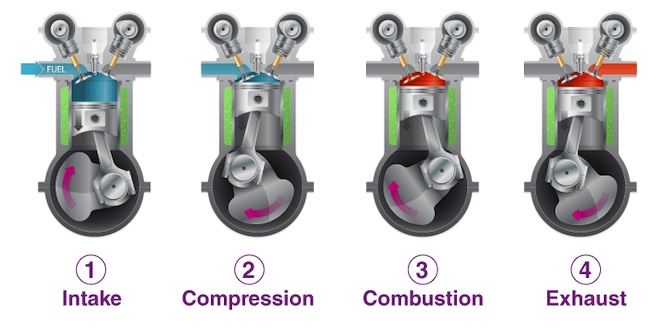A four-stroke engine is an internal combustion engine that utilizes four distinct piston strokes (intake, compression, power, and exhaust) to complete one operating cycle. A complete operation in a four-stroke engine requires two revolutions (720°) of the crankshaft.
Parts of a Four Stroke Engine
Piston
In an engine, a piston transfers the expanding forces of gas to mechanical rotation of the crankshaft through a connecting rod.
Crankshaft
A crankshaft is a part that converts the reciprocating motion to rotational motion.
Connecting Rod
It transfers motion from a piston to crankshaft acting as a lever arm
Flywheel
The flywheel is a rotating mechanical device that is used to store energy.
Inlet and Outlet Valves
It allows us to enter fresh air with fuel & to exit the spent air-fuel mixture from the cylinder.
Spark Plug
It is a device that delivers electric current to the combustion chamber which ignites the air-fuel mixture leading to the abrupt expansion of gas.
Four Stroke Engine Cycle
The four strokes of the engine go by the following names:

Suction/Intake Stroke
Intake stroke occurs when the air-fuel mixture is introduced to the combustion chamber. In this stroke, the piston moves from TDC (Top Dead Center – the farthest position of piston to the crankshaft) to BDC (Bottom Dead Center – the nearest position of piston to the crankshaft.) The movement of the piston towards the BDC creates a low-pressure area in the cylinder. The inlet valve remains to open a few degrees of crankshaft rotation after BDC. The intake valve then closes and the air-fuel mixture is sealed in the cylinder
- Inlet Valve – Open
- Outlet Valve – Closed
- Crankshaft Rotation – 180°
Compression Stroke
In compression stroke, the trapped air-fuel mixture is compressed inside the cylinder. During the stroke, the piston moves from BDC to TDC compressing the air-fuel mixture. The momentum of the flywheel helps the piston move forward. Compressing the air-fuel mixture allows more energy to be released when the charge is ignited. The charge is the volume of compressed air-fuel mixture trapped inside the combustion chamber ready for ignition. The inlet and outlet valves must be closed to ensure that the cylinder is sealed resulting in compression.
- Inlet Valve – Closed
- Outlet Valve – Closed
- Crankshaft Rotation – 180° (Total 360°)
Power/Combustion Stroke
The second rotation of the crankshaft has begun when it completes a full rotation during the compression stroke. The power stroke occurs when the compressed air-fuel mixture is ignited with the help of a spark plug. Ignition or Combustion is the rapid, oxidizing chemical reaction in which a fuel chemically combines with oxygen in the atmosphere and releases energy in the form of heat. The hot expanding gases force the piston head away from the cylinder head.
- Inlet Valve – Closed
- Outlet Valve – Closed
- Crankshaft Rotation – 180° (Total 540°)
Exhaust Stroke
As the piston reaches BDC during the power stroke, combustion is complete and the cylinder is filled with exhaust gases. The exhaust valves open during this stroke and the inertia of the flywheel and other moving parts push the piston back to TDC, forcing the exhaust gases through the open exhaust valve. At the end of the exhaust stroke, the piston is at TDC and one operating cycle has been completed.
- Inlet Valve – Closed
- Outlet Valve – Open
- Crankshaft Rotation – 180° (Total 720°)
Comparison Between 2-stroke engine and a 4-stroke engine
- A 4-stroke engine weighs 50% heavier than a 2-stroke engine.
- A 4-stroke engine is more efficient than a 2-stroke engine because fuel is consumed once every 4 strokes.
- A 2-stroke engine creates more torque at a higher RPM, while a 4-stroke engine creates a higher torque at a lower RPM.
- A 4-stroke engine is quieter than a 2-stroke engine.
- 2-stroke engines tend to wear out fast because they are designed to run at a higher RPM.
- 2-stroke engines are easier to fix because of simple construction. 4-stroke engines have complex designs with more parts making them more expensive and repairs cost more.
Two-stroke engines are typically found in smaller applications such as chainsaws, boat motors, and dirt bikes. Four-stroke engines are found in go-karts, lawnmowers, and combustion engines in your car.